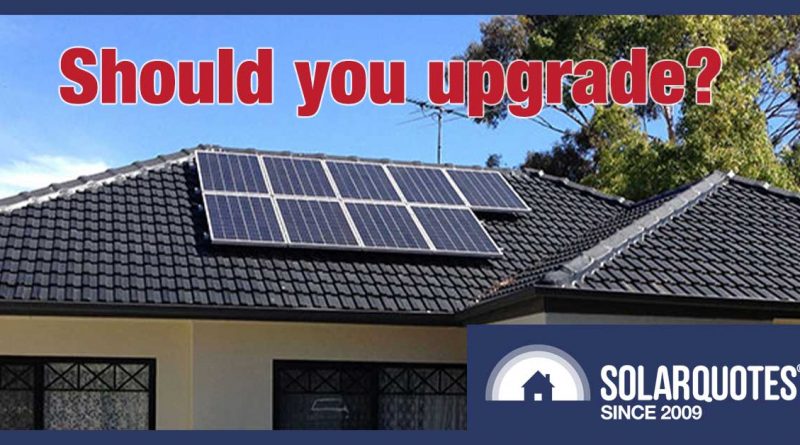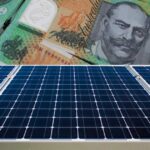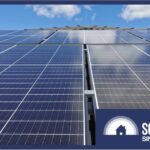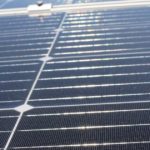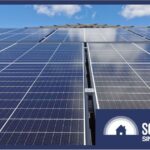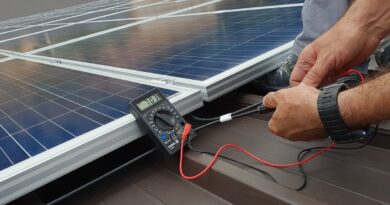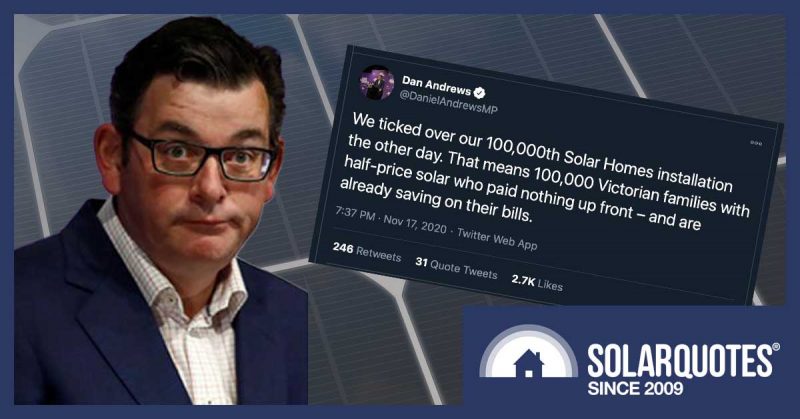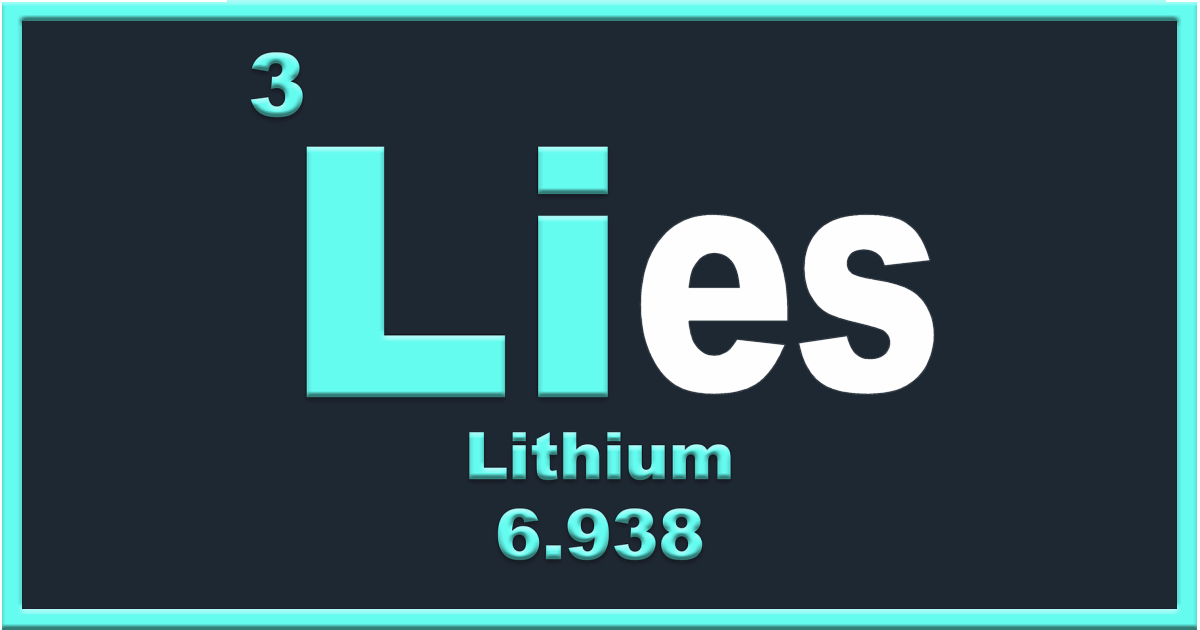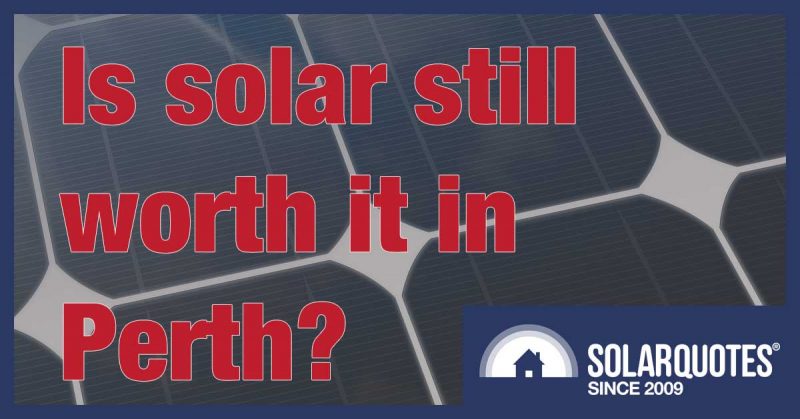Scrap Your Old Solar System & High Feed-in Tariff For A Bigger & Better Return
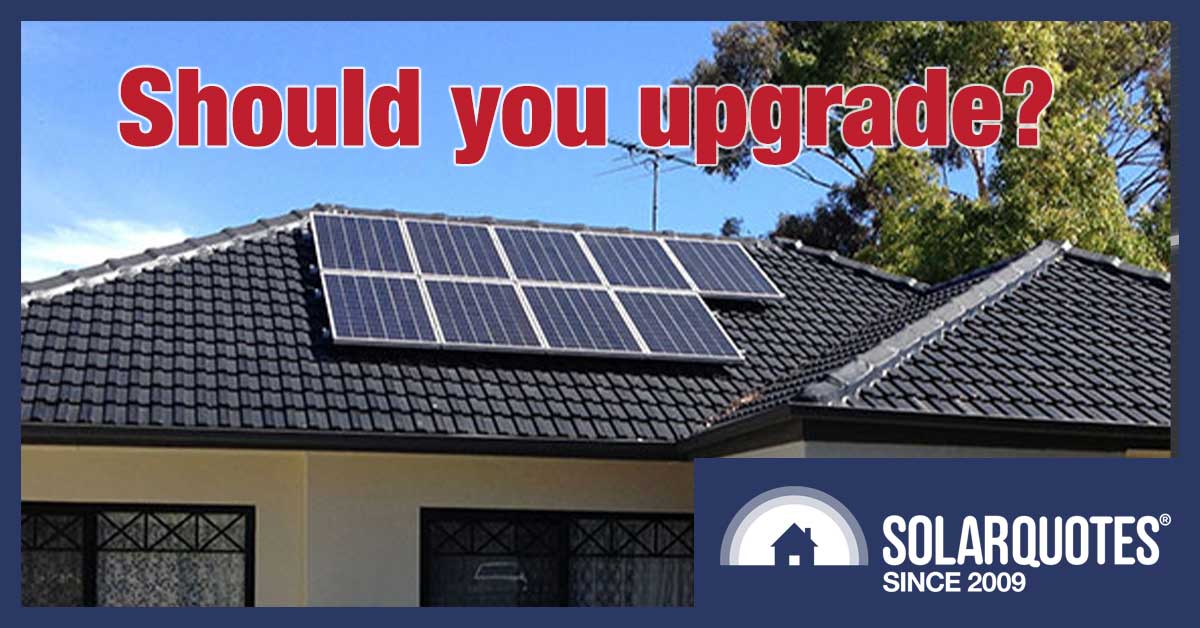
If you have a small, old system, replacing it with a bigger, more efficient modern system is worth serious consideration. Even if it means losing that premium feed-in-tariff you’ve enjoyed for all these years.
Do you have a faithful, old, 1.5 kilowatt solar system installed?
Has it sat on your roof churning photons into electrical energy for 10 years or more?
Has it earned you a heap of money because it gets an old, premium feed-in tariff far higher than anything available now?
If so, congratulations! It’s been a loyal and valuable addition to your household and has likely earned you much more than the massive amount you probably paid for it.
But, if you want to make more money, odds are you should scrap that small old system and replace it with a new larger installation. In Adelaide and Darwin, you’re almost certain to come out ahead, while in Canberra, Brisbane, and Melbourne it can still pay – provided your solar self-consumption and daytime electricity use is average or higher.
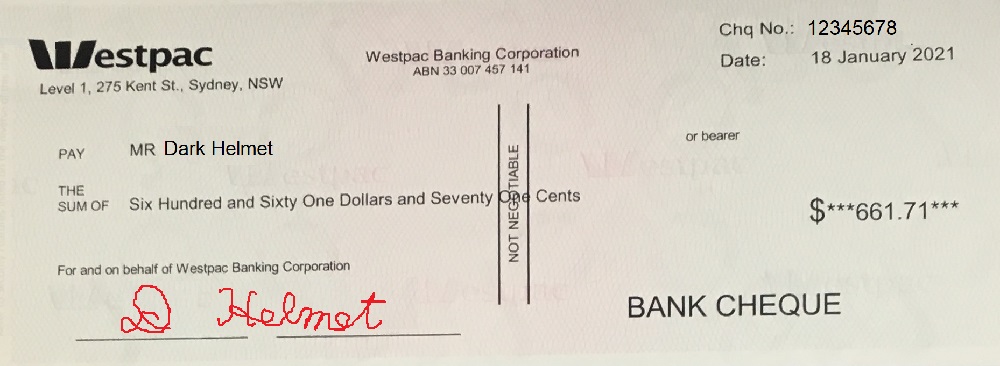
The usual ways to get a large annual credit on your electricity bills is to either have a reasonably large solar system or small system and a locked-in large feed-in tariff.
2 kW is the magic number for premium feed-in-tariffs
If a solar system is over 2 kilowatts and receiving a high feed-in tariff, then replacing it is unlikely to save money unless your daytime electricity consumption is high or you are willing to make an effort to shift your electricity consumption to the day.
But even if your electricity consumption isn’t high, if you consider the atmosphere’s energy balance to be more important than your bank balance, you may want to get a larger system anyway.
Where Are The Remaining High Feed-In Tariffs?
Three years ago I wrote about if replacing small old solar power systems receiving high feed-in tariffs made financial sense and concluded it often didn’t. But times have changed and an up-to-date article is called for.
Since I wrote my previous article the high feed-in tariffs have come to an end in NSW and Tasmania. This leaves three states and two territories where they’re still around. Western Australia’s has already mostly finished and will be completely over by July. As far as this article is concerned, I’m going to regard their jacked-up tariff as over.
The remaining locations where old solar systems are still receiving big fat, locked-in, feed-in tariffs are:
- The ACT
- The Northern Territory
- Queensland
- South Australia
- Victoria
If you have an old solar power system installation of around 1.5 kilowatts in any location that doesn’t receive a high feed-in tariff it will normally make financial sense to replace it with a new larger system, no matter where you are. The possible exception is Western Australia where households with low electricity consumption may be better off sticking with a small system due to the low feed-in tariffs available for new solar in that state.
How Much Are Those Old Tariffs?
Since states and territory use different terminology, I’m simply going to call them Premium Feed-in Tariffs. I can’t just refer to them as old and high and making lots of money because that brings up bad connotations.

The remaining Premium Feed-in Tariffs that will be around for more than a few months are:
- The ACT: A 45 cent gross tariff for every kilowatt-hour generated regardless of how little or how much electricity the home consumes. Lasts 20 years and the final ones will end in 2031.
- The Northern Territory: Equal to the per-kilowatt-hour charge for grid electricity and currently 26 cents. No end point given so far.
- Queensland: 44 cents + retailer tariff. Can easily total over 50 cents. Ends 1st July 2028.
- South Australia: 44 cents + retailer tariff. Can total over 55 cents. Ends 1st July 2028.
- Victoria: 60 cents + retailer tariff. Can total over 70 cents. Ends in late 2024.
As you can see, Victoria has one hell of a Premium Feed-in Tariff. Unfortunately for those in Melbourne, that city has the lowest solar output of any mainland location.
Annual Savings With Premium Feed-in Tariff & Without
Luckily for me, the SolarQuotes Solar & Battery Calculator makes it very easy to find the expected annual electricity bill savings from a 1.5 kilowatt system with a Premium Feed-in Tariff and compare it to what would be received by replacing it with a larger solar system. In this case, I am going to look at a 6.6 kilowatt solar system because it’s a commonly installed system size, but this doesn’t mean you shouldn’t consider a larger system.
Taking into account…
- Your budget
- Roof space, and…
- What you are permitted to install
It will often make sense to go larger than 6.6 kilowatts, even if it’s necessary to export limit your solar system.
The graph below contrasts annual electricity bill savings from two very different solar panel systems:
- A 1.5 kilowatt, north-facing system, receiving a Premium Feed-in Tariff that has suffered no significant deterioration in output since it was installed, and…
- A new 6.6 kilowatt, north-facing solar system installation, receiving a current feed-in tariff.
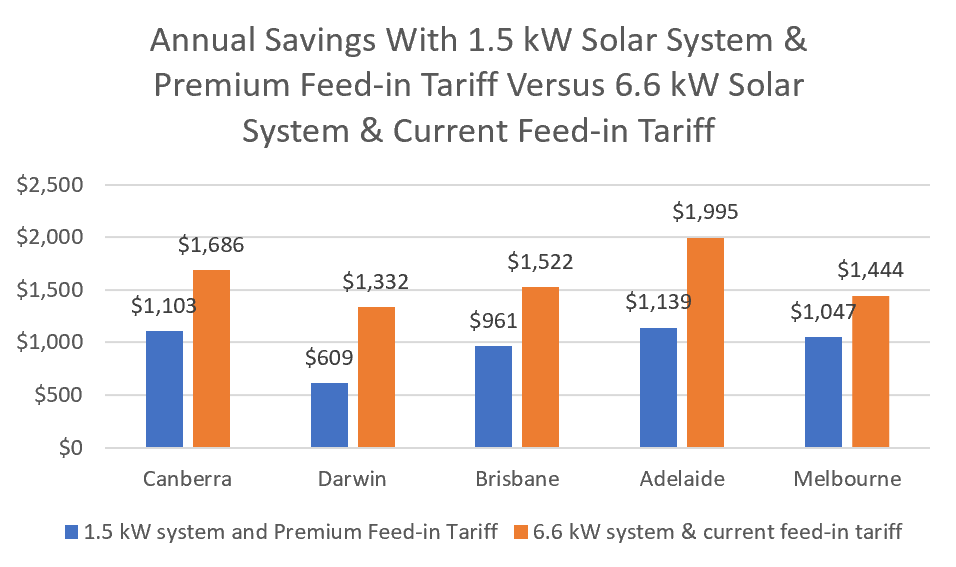
As you can see, the savings in each capital1 from a 6.6 kilowatt solar power system with a current feed-in tariff clearly exceed those from a 1.5 kilowatt solar system with a Premium Feed-in Tariff.
If I make a graph just showing how much more a 6.6 kilowatt system saves compared to a 1.5 kilowatt system with a Premium Feed-in Tariff over a year, it looks like this:
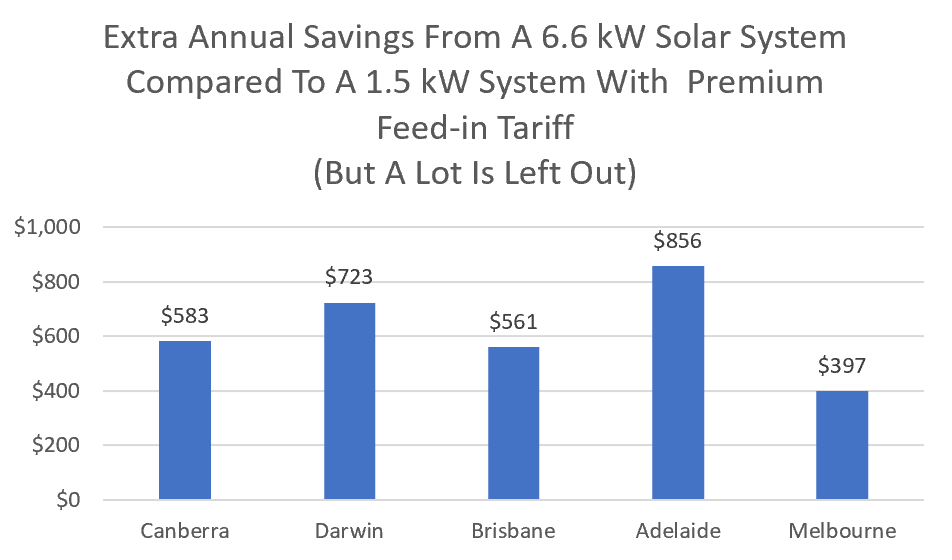
The difference is clearly greatest in Adelaide and least in Melbourne. However, as the graph’s title suggests, a lot has been left out and it’s far from being a fair comparison.
Not The Full Story
While it would be nice and easy to end the article here, there are a number of other factors that need to be considered. The five main ones are:
- The cost of capital
- Wear and tear on the new system
- Declining feed-in tariffs and electricity prices
- Deterioration of solar systems
- Solar self consumption
I’ll go over all of these, but first I’ll consider what a new solar panel system install is likely to cost.
Solar System Cost
Having a large, brand new, solar system installed on your roof is a pretty good idea. Not only will it reduce or potentially eliminate your electricity bills by providing clean energy, but it will also help keep your home cool and protect your roof. The only real disadvantage is it costs money.
The good news here is systems with reliable hardware can be bought from installers who do high-quality work at very reasonable costs these days. So long as you’re not beyond the black stump and don’t have a roof that’s difficult to install on, it’s possible to get a quality 6.6 kilowatt system for under $5,000.
This won’t pay for the best components available, but it will pay for solar panels that will last for decades and an inverter that will operate for over ten years. Provided you’re careful and do your research, you can avoid dodgy installers and find someone who does high-quality work. Or you could get quotes from installers through us.
Cost Of Capital
Money has a cost. This can be the interest when you borrow it or the return you could have received from investing it.
If you borrow $5,000 to pay for a new solar system, the cost of capital is easy to work out, as it’s equal to the loan’s interest rate. But if you don’t borrow and pay with money you already have, the cost of capital is equal to the rate of return of whatever investment you would have otherwise made using that money. If you would have used it to pay off a home loan at 3% then it’s 3%. If you’d instead spend it on getting a bunch of nuts into a tub full of whiskey and egg whites, you can determine for yourself what kind of return that gives you.

These Pecan Whiskey Meringues are nuts. Recipe here. (Image Source: Diary of a Mad Hausfrau.)
If you could have instead invested the money at 5% then a $5,000 solar system will cost you the $250 a year you could have made from that investment.
Because interest rates are low, I’ll assume a rate of 4%, which comes to $200 a year for a $5,000 system installation. But someone who is a brilliant investor or owes money to the mafia may consider double that to be a more appropriate rate. If $200 is subtracted from the annual net benefit from a 6.6 kilowatt system to account for the cost of capital, then a new system is still worthwhile in all the locations:
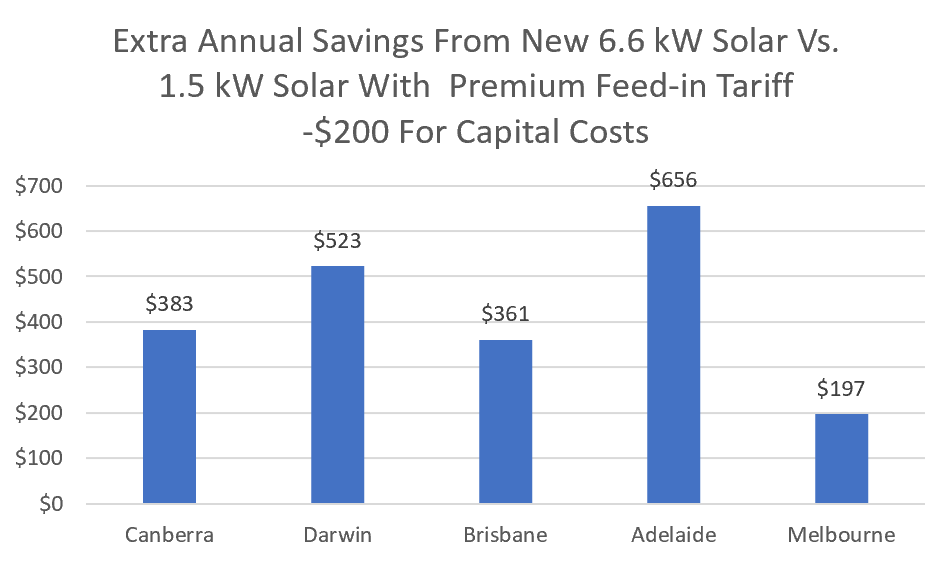
Wear & Tear
If you currently have an old, small, solar system installed on your roof, it will suffer wear and tear. That’s unavoidable as it’s out in the elements being fried by the sun and soaked by rain. The only way to stop it is to scrap it. But replacing it with a new system is a choice you can put off. And deciding not to install a new system until your Premium Feed-in Tariff ends delays the start of wear and tear on it and pushes the need to eventually replace the new system further into the future.
Just how much to allow for wear and tear and a system’s eventual need for replacement is difficult to determine. I expect quality modern solar power systems will last over 30 years2 and will cost significantly less to replace that far in the future. But many people won’t stay in one location for that long, which complicates the issue.
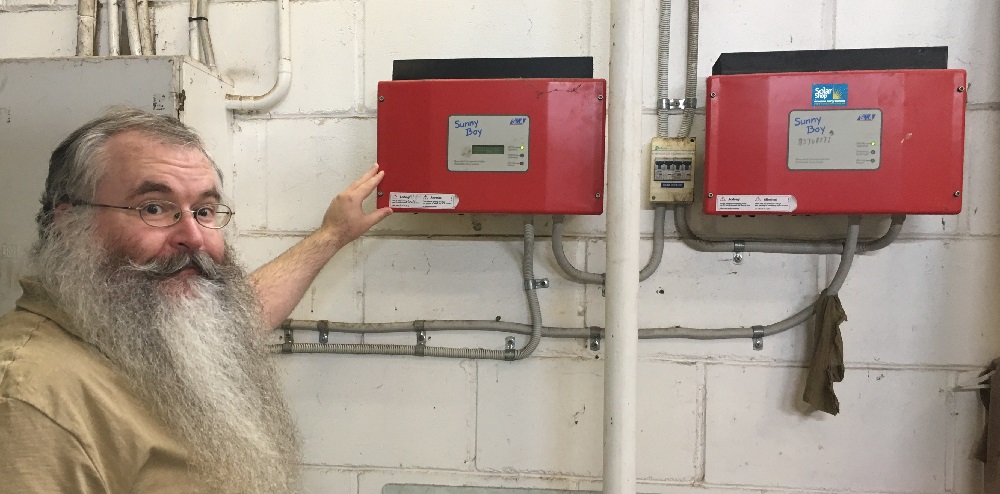
These SMA Sunny Boy inverters are part of one of the oldest solar installations in Adelaide, so everything in this photo is old. One inverter has operated for 21 years while the other was added a few years later when the system was expanded. The fact they’re still going strong is an impressive display of reliability.
To keep it simple, I’ll allow $125 for wear and tear per year. I’m keeping everything in today’s money, so after 20 years this will come to $2,500 to replace the system if necessary at that point. It may be optimistic to assume that much will be enough, given that STCS that lower the cost of rooftop solar will be gradually reduced to nothing over the next 10 years, but 20 years ago a 4.5 kilowatt system was around $45,000 in today’s money. Hence, a price drop of 50% isn’t extreme compared to what has happened over the previous 20 years.
If $125 a year to account for wear and tear is added on top of $200 for the cost of capital, then a new 6.6 kilowatt system installation comes out this much ahead per year over a 1.5 kilowatt system with a Premium Feed-in Tariff:
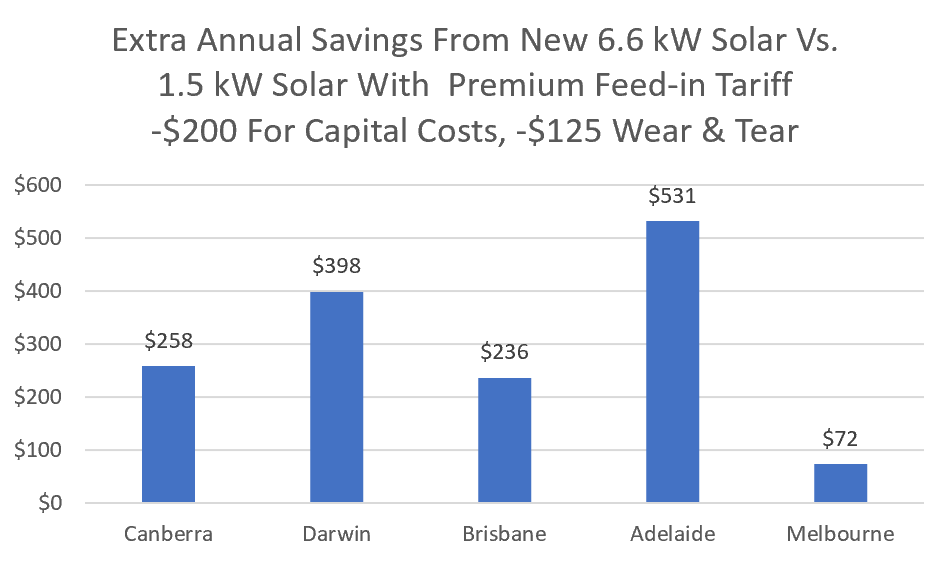
A new system still comes out ahead in all the locations, but Melbourne’s looking a bit ropey.
Declining Feed-in Tariffs & Electricity Prices
Solar feed-in tariffs won’t disappear anytime soon, but their general direction is heading downwards as solar capacity increases. The lower current solar feed-in tariffs get, the greater the value there is from keeping an old system with a high Premium Feed-in Tariff. Electricity prices are also falling and reducing the return from rooftop solar.
To allow for this, I’m going to reduce the current feed-in tariffs given by the SolarQuotes Solar & Battery Calculator by 20% and the per-kilowatt-hour charges for grid electricity by 10%.
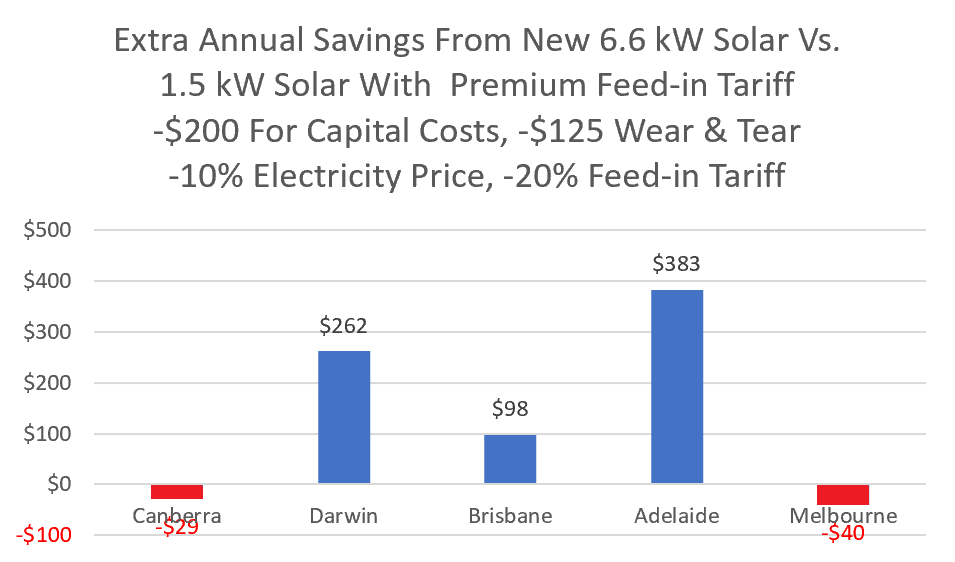
Both Canberra and Melbourne are now slightly in the red. But things will look better if we take into account that older systems will have some deterioration in output and their inverters were generally less efficient.
System Deterioration
It’s an unfortunate fact solar systems slowly decline in output over time. Unless, of course, the panels are crap. In this case, the decline can be rapid and serious problems or total failure can occur within a few years. While the problem isn’t as bad today, a lot of crap solar panels installed in the past, so some old 1.5 kilowatt systems now only provide a fraction of the output they should.
But I am going to ignore the crap ones and only consider systems with good quality panels that have only suffered mild deterioration. I’m going to assume these 1.5 kilowatt systems that are now mostly 10 or 11 years old have only had their output reduced by 5%.
Another factor that isn’t deterioration, but I’ll include here, is that modern inverters are more efficient than they were in the past. Also, larger inverters tend to be slightly more efficient than smaller ones. To account for this, I’m going to increase the deterioration due to age by 3% up to 8%. This gives:
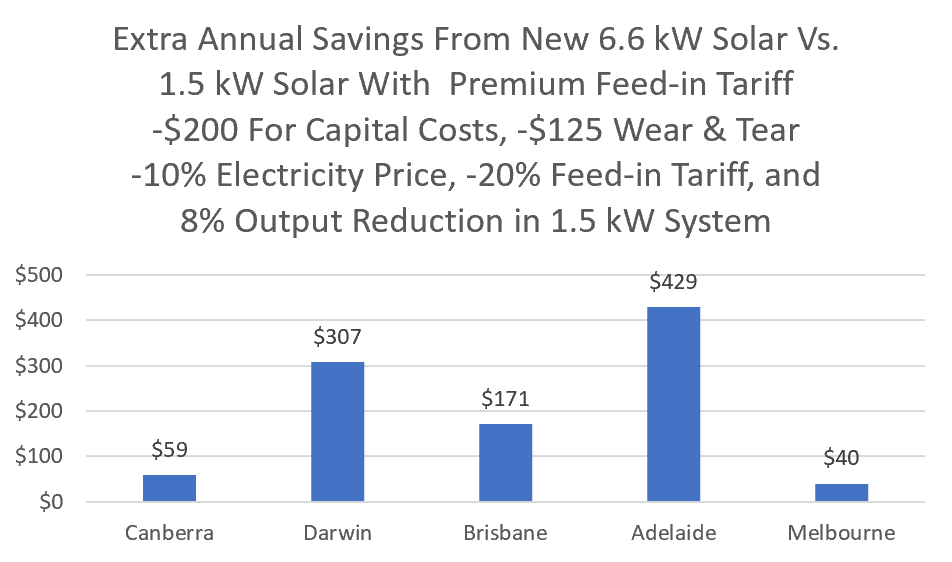
So after accounting for capital costs, wear and tear, falling electricity prices and feed-in tariffs, and system deterioration plus lower inverter efficiency, then — provided the assumptions I’ve used are reasonable for your circumstances — it looks like replacing an old 1.5 kilowatt solar panel system receiving a Premium Feed-in Tariff with a 6.6 kilowatt or larger system installation is likely to make financial sense in all the locations. But this will only hold for households with average electricity consumption and solar self-consumption, because those are the defaults the SolarQuotes Solar & Battery Calculator uses.
Systems Over 1.5 kW & Premium Tariffs
So far I’ve focused on 1.5 kilowatt solar systems and there’s a good reason for that. Due to the way incentives used to work, that is by far the most common system size receiving a Premium Feed-in Tariff. But there is variation. Some were only one kilowatt while others were two or three kilowatts. Some enthusiastic people with deep pockets even went as far as installing 5 kilowatt systems. These were regarded as absolutely massive back then, but I now consider them undersized for most households.
Provided it’s still working acceptably, the larger the solar power system receiving a Premium Feed-in Tariff, the less likely it is to make financial sense to replace it with a new larger system. Just going from 1.5 to 2 kilowatts makes a big difference, as the following graph shows. It the same as the previous graph, but for a 2 kilowatt system:
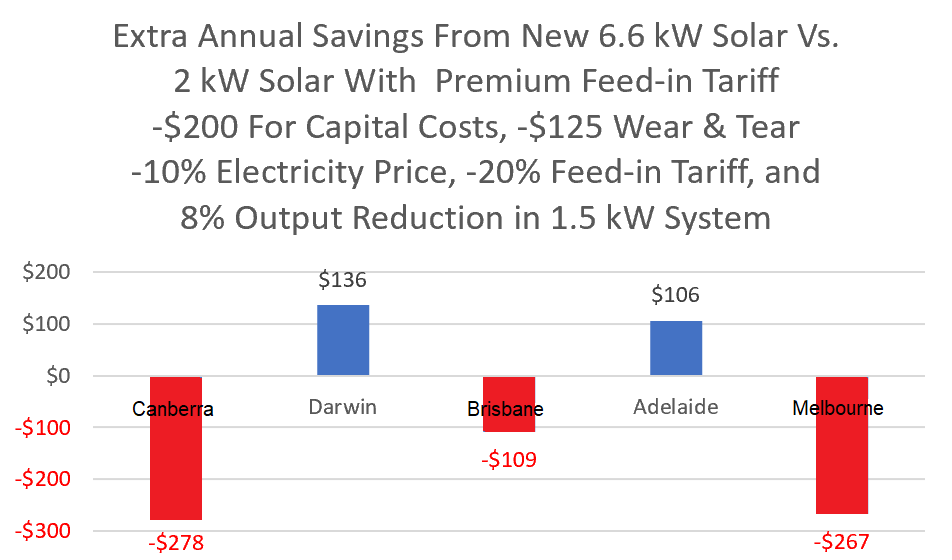
As you can see, only in Darwin and Adelaide does it make sense to replace a 2 kilowatt system with a Premium feed-in tariff. If a solar system is 3 kilowatts or larger and receiving a Premium Feed-in Tariff then it won’t make financial sense to replace it with a 6.6 kilowatt new system installation anywhere.
Solar Self Consumption
Normally the larger the percentage of solar energy your home consumes the better the return on the system. This is because the cost of grid electricity is much higher than modern feed-in tariffs. But the old Premium Feed-in Tariffs turn this around by being higher than what household are charger per kilowatt-hour for electricity — or exactly equal to it in the Northern Territory. So the lower a home’s solar self-consumption, the more valuable an old solar panel system with a Premium Feed-in Tariff can be.
Generally speaking, the smaller a solar system, the higher its self-consumption percentage will be. So far I’ve used a 50% self-consumption rate for 1.5 kilowatt systems while for new 6.6 kilowatt systems I’ve used the average self-consumption percentage for a system that size in it’s location. This has ranged from 20% in Brisbane to 31% in Melbourne.
But if there is usually no one at home during daylight hours and little or no attempt is made to shift electricity use to the day, then a home can have a much lower self-consumption percentage. If we lower the self-consumption for 1.5 kilowatt systems with Premium Feed-in Tariffs to 30% and halve the typical self-consumption percentage for 6.6 kilowatt systems then, including the other adjustments, it gives:
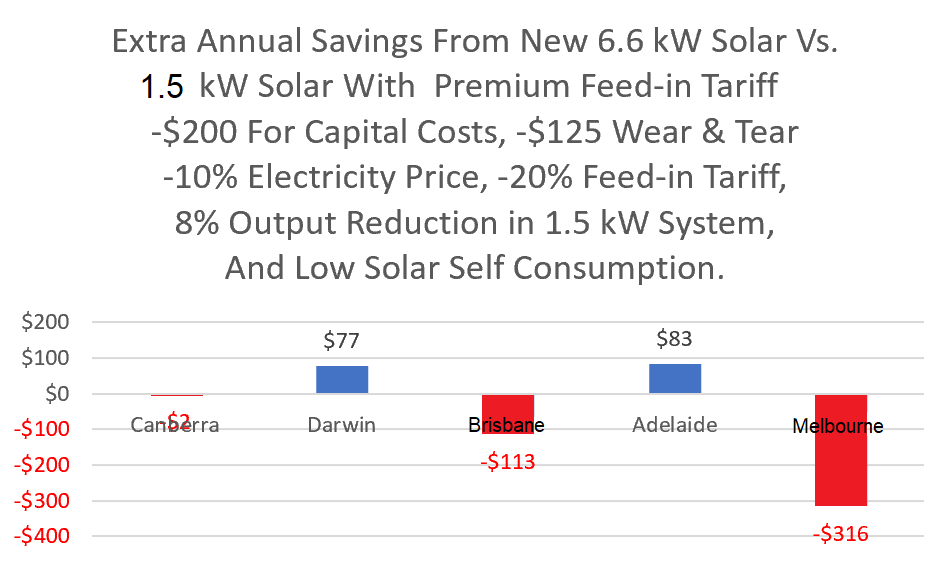
So replacing an old 1.5 kilowatt solar system receiving a Premium Feed-in Tariff in Darwin and Adelaide is very likely to pay for itself, even with low solar self-consumption. It will probably pay for itself in Canberra, while in Brisbane and Melbourne, it won’t pay for homes with low solar self-consumption, but is likely to pay for those with average solar self-consumption and electricity use.
Two Other Factors
There are a couple of other factors that can affect the results:
- Export limits, and…
- Panel Orientation.
Export Restrictions
I’ve assumed when a home updates to a 6.6 kilowatt solar system, it will be able to export solar energy to the grid normally and won’t be export limited below the normal amount. But this may occur and, while it can definitely reduce the return from a larger system, provided the restriction isn’t too severe and a modest effort is put into shifting electricity consumption to the daytime, installing a larger system can still be financially viable.
Panel Orientation
Most solar systems receiving a Premium Feed-in Tariff face as north as their roof allows, maximizing their output. But because larger systems have more panels it can be harder to face them all in the best direction. This difference in orientation can give the smaller system a modest advantage in generation per kilowatt of solar panels. Countering this is the fact that having the panels of a larger system facing in more than one direction can help improve solar self-consumption, which is an advantage for a new system. This means panel orientation is not always to the advantage of the smaller system.
Also, solar systems are much more compact per kilowatt than they used to be. Many old 1.5 kilowatt systems have 10 panels of 150 watts each, but these days a 6.6 kilowatt system installation can have under 20 solar panels.
Better To Replace Than Repair
Even if you are happy keeping your old 1.5 kilowatt, Premium Feed-in Tariff system, if the inverter fails or its output starts falling, in the large majority of cases it will make financial sense to replace it rather than pay to repair it. A modern solar power system can require less than a year to pay back the energy required to create and install it, so besides making dollars and cents, it can make good environmental sense to put a new, larger solar system and have it start producing extra clean energy.
If the system is over 2 kilowatts then it’s likely to make financial sense to have it repaired, although this may not be the case in Victoria where there are less than three years remaining for their Premium Feed-in Tariff.
Footnotes
- I’ve provided information for capitals because that’s where most of the solar systems receiving Premium Feed-in Tariffs will be. If your solar system is located in the Simpson Desert rather than Brisbane, your results may differ. ↩
- Although I would expect most to need one inverter replacement in that time. ↩
Original Source: https://www.solarquotes.com.au/blog/upgrade-replace-solar/

